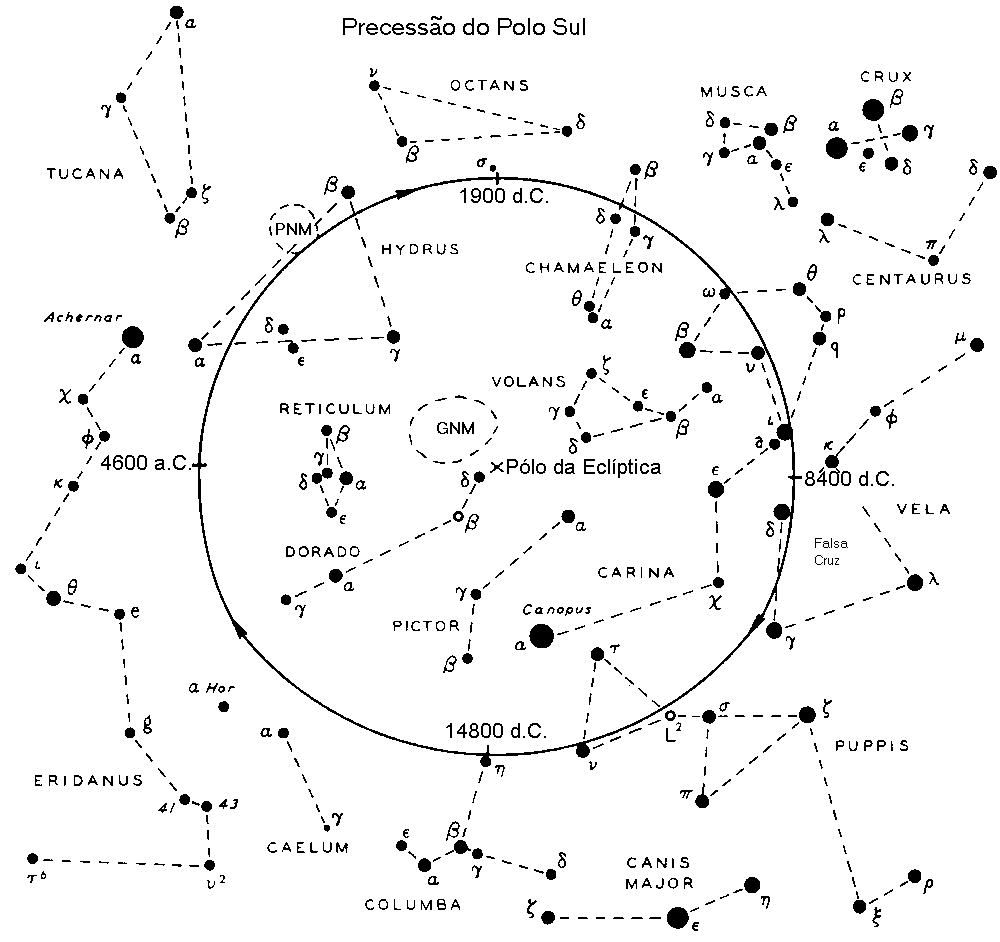South pole stars
South pole stars
Just a question, are there any bright stars are near the path of the south pole as a result of precession of the equinoxes, and thus could be used as south pole stars at some point in time a few thousand years in the past or future? The only sources I can find only list various north pole stars (e.g. Polaris, Thuban, Vega)
-
StarSeeker
- Posts: 44
- Joined: 30.08.2005
- With us: 18 years 10 months
- Location: Urbandale, IA
- Contact:
-
Michael Kilderry
- Posts: 499
- Joined: 11.10.2004
- With us: 19 years 8 months
- Location: London, UK
I've looked this topic up in a book called "Skywatching" by David H. Levy. According to this book, the south pole will pass into the constellation of Carina in about 3,000 years and will get near Delta Carinae in about 7,000 years. This 2nd magnitude star will be the brightest south polar star the Earth ever sees.
My shatters.net posting milestones:
First post - 11th October 2004
100th post - 11th November 2004
200th post - 23rd January 2005
300th post - 21st February 2005
400th post - 23rd July 2005
First addon: The Lera Solar System
- Michael
First post - 11th October 2004
100th post - 11th November 2004
200th post - 23rd January 2005
300th post - 21st February 2005
400th post - 23rd July 2005
First addon: The Lera Solar System
- Michael
I have also done some research into this topic, and have encountered a similar strong boreocentric bias to the available information. There are very few (if any) websites that address this to any great degree of precision for the SCP.
The definition of "pole star" needs to be clarified. How close to the pole does a star have to be to count as a pole star? Various sources for the northern hemisphere state that Vega will be a pole star in about 12,000 years, yet it appears that Vega may only be within 5 degrees or so of the pole. If this is correct (I have ignored the effects of proper motion), then it's worth noting that Canopus will pass within 10 degrees of the SCP during the precession cycle. While Canopus is not close enough to be a pole star as such, having the second brightest star in the sky situated so close to the SCP would still be a useful navigational guide.
For the southern hemisphere, there is a sequence of stars of the fourth magnitude and brighter that will pass close enough to the pole to be useful pole stars during the next 8,000 years. This list of stars includes Gamma Chamaeleontis, HD 90589, Omega Carinae, Upsilon Carinae, Iota Carinae (Aspidiske) and Delta Velorum. This list is probably not accurate, because I had to work it out for myself. I would like to find a more accurate list of pole stars, complete with the years they are closest to the pole.
The definition of "pole star" needs to be clarified. How close to the pole does a star have to be to count as a pole star? Various sources for the northern hemisphere state that Vega will be a pole star in about 12,000 years, yet it appears that Vega may only be within 5 degrees or so of the pole. If this is correct (I have ignored the effects of proper motion), then it's worth noting that Canopus will pass within 10 degrees of the SCP during the precession cycle. While Canopus is not close enough to be a pole star as such, having the second brightest star in the sky situated so close to the SCP would still be a useful navigational guide.
For the southern hemisphere, there is a sequence of stars of the fourth magnitude and brighter that will pass close enough to the pole to be useful pole stars during the next 8,000 years. This list of stars includes Gamma Chamaeleontis, HD 90589, Omega Carinae, Upsilon Carinae, Iota Carinae (Aspidiske) and Delta Velorum. This list is probably not accurate, because I had to work it out for myself. I would like to find a more accurate list of pole stars, complete with the years they are closest to the pole.
-
PlutonianEmpire

- Posts: 1374
- Joined: 09.09.2004
- Age: 39
- With us: 19 years 9 months
- Location: MinneSNOWta
- Contact:
I have not, but I remembered to state that.PlutonianEmpire wrote:Do you take into account that the stars themselves also move as well?
I have ignored the effects of proper motion
If anyone can verify or refute the accuracy of my list, it would be useful.
One note: I believe Delta Velorum is the same star as Delta Carinae. Vela, Carina, Pyxis and Puppis are all parts of the old constellation Argo Navis, and these constellations share a single set of Bayer letters. I will need to verify what the correct name of the star is.
Here is a drawing that could be of some help.
first, some portuguese:
Precess??o do P??lo Sul = Precession of the South Pole
a.C = BC
d.C = AD
Cruzeiro: Southern Cross
GNM= LMC (Large Magellanic Cloud)
PNM= SMC (small Magellanic Cloud) =>note how close it is from the precession cycle!!
P??lo da Ecl?ptica = ecliptic pole
Falsa Cruz = False Cross (formed by two stars of Vela and two stars of Carina. This name is due to it's similarity to the Southern Cross)

first, some portuguese:
Precess??o do P??lo Sul = Precession of the South Pole
a.C = BC
d.C = AD
Cruzeiro: Southern Cross
GNM= LMC (Large Magellanic Cloud)
PNM= SMC (small Magellanic Cloud) =>note how close it is from the precession cycle!!
P??lo da Ecl?ptica = ecliptic pole
Falsa Cruz = False Cross (formed by two stars of Vela and two stars of Carina. This name is due to it's similarity to the Southern Cross)

